Paper Menu >>
Journal Menu >>
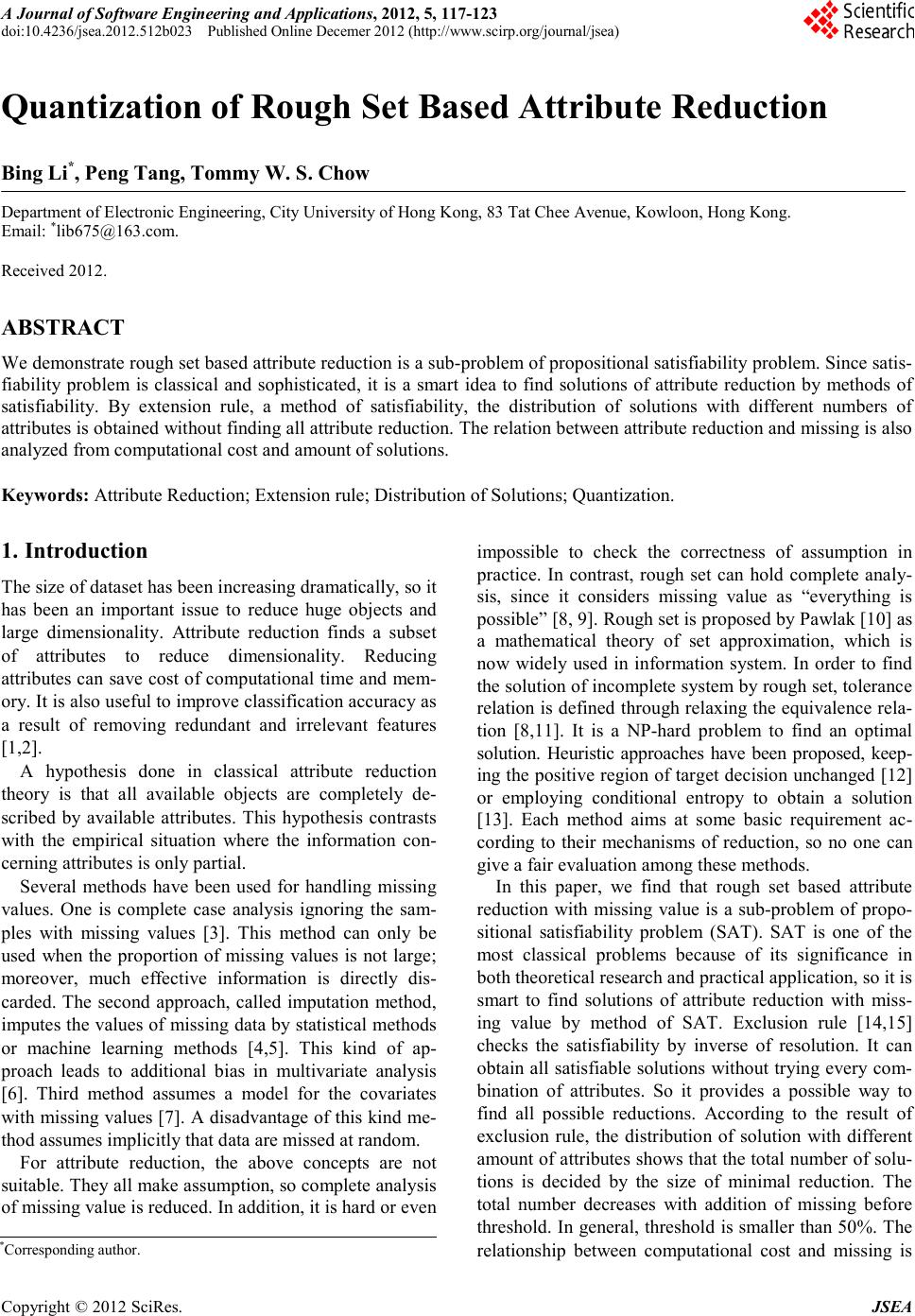 A Journal of Software Engineering and Applications, 2012, 5, 117-123 doi:10.4236/jsea.2012.512b023 Published Online Decemer 2012 (http://www.scirp.org/journal/jsea) Copyright © 2012 SciRes. JSEA Quantization of Rough Set Based Attribute Reduction Bing Li*, Peng Tang, Tommy W. S. Chow Department of Electronic Engineering, City University of Hong Kong, 83 Tat Chee Avenue, Kowloon, Hong Kong. Email: *lib675@163.com. Received 2012. ABSTRACT We demonstrate rough set based attribute reduction is a sub-problem of propositional satisfiability problem. Since satis- fiability problem is classical and sophisticated , it is a smart idea to find solutions of attribute reduction by methods of satisfiability. By extension rule, a method of satisfiability, the distribution of solutions with different numbers of attributes is obtai ned without findin g all attrib ute r eductio n. T he r elatio n bet ween attribute red uction and missi n g is also analyzed from computational cost and amount of solutions. Keywords: Attribute Reduction; Extension rule; Distribution of Solutions; Quantization. 1. Introduction The size of dataset has been incr easing dra matically, so i t has been an important issue to reduce huge objects and large dimensionality. Attribute reduction finds a subset of attributes to reduce dimensionality. Reducing attributes ca n save cost of computational t im e a nd mem- ory. It is also u seful to i mprove classification accuracy as a result of removing redundant and irrelevant features [1,2]. A hypothesis done in classical attribute reduction theory is that all available objects are completely de- scribed by available attributes. This hypothesis contrasts with the empirical situation where the information con- cerning attributes is only partial. Several methods have been used for handling missing values. One is complete case analysis ignoring the sam- ples with missing values [3]. This method can only be used when the proportion of missing values is not large; moreover, much effective information is directly dis- carded. The second approach, called imputation method, imputes the values of missing data by statistical methods or machine learning methods [4,5]. This kind of ap- proach leads to additional bias in multivariate analysis [6]. Third method assumes a model for the covariates with mi ssing val ues [7]. A disadvanta ge of t his ki nd me- thod assu mes implicitly that da ta a r e missed a t random. For attribute reduction, the above concepts are not suitable. The y all make assumption, so complete analysis of missing value is reduced. In addition, it is hard or even impossible to check the correctness of assumption in practice. In contrast, rough set can hold complete analy- sis, since it considers missing value as “everything is possible” [8, 9]. Rough set i s pr o po sed by Pawlak [10] as a mathematical theory of set approximation, which is now widely used in information system. In order to find the solution of inco mplete syste m by rough set, tolera nce relation is de fined t hrough rel axing t he equivalenc e rela- tion [8,11]. It is a NP-hard problem to find an optimal solution. Heuristic approaches have been proposed, keep- ing the po sitive r egio n of target decision unchanged [12] or employing conditional entropy to obtain a sol ution [13]. Each method aims at some basic requirement ac- cording to their mechanisms of reduction, so no one can give a fair e valuat ion among these metho ds. In this paper, we find that rough set based attribute reduction with missing value is a sub-problem of propo- sitional satisfiability problem (SAT). SAT is one of the most classical problems because of its significance in both theoretical research a nd practical ap p lic atio n, so it is smart to find solutions of attribute reduction with miss- ing value by method of SAT. Exclusion rule [14,15] checks the satisfiability by inverse of resolution. It can obtain all satisfiable solutions without trying every com- bination of attributes. So it provides a possible way to find all possible reductions. According to the result of exclusion rule, the distributio n of solution with different amount of attribute s shows that the to tal number of solu- tions is decided by the size of minimal reduction. The total number decreases with addition of missing before thres hold. I n general, threshol d is smalle r t han 50%. T he relationship between computational cost and missing is *Corresponding author. 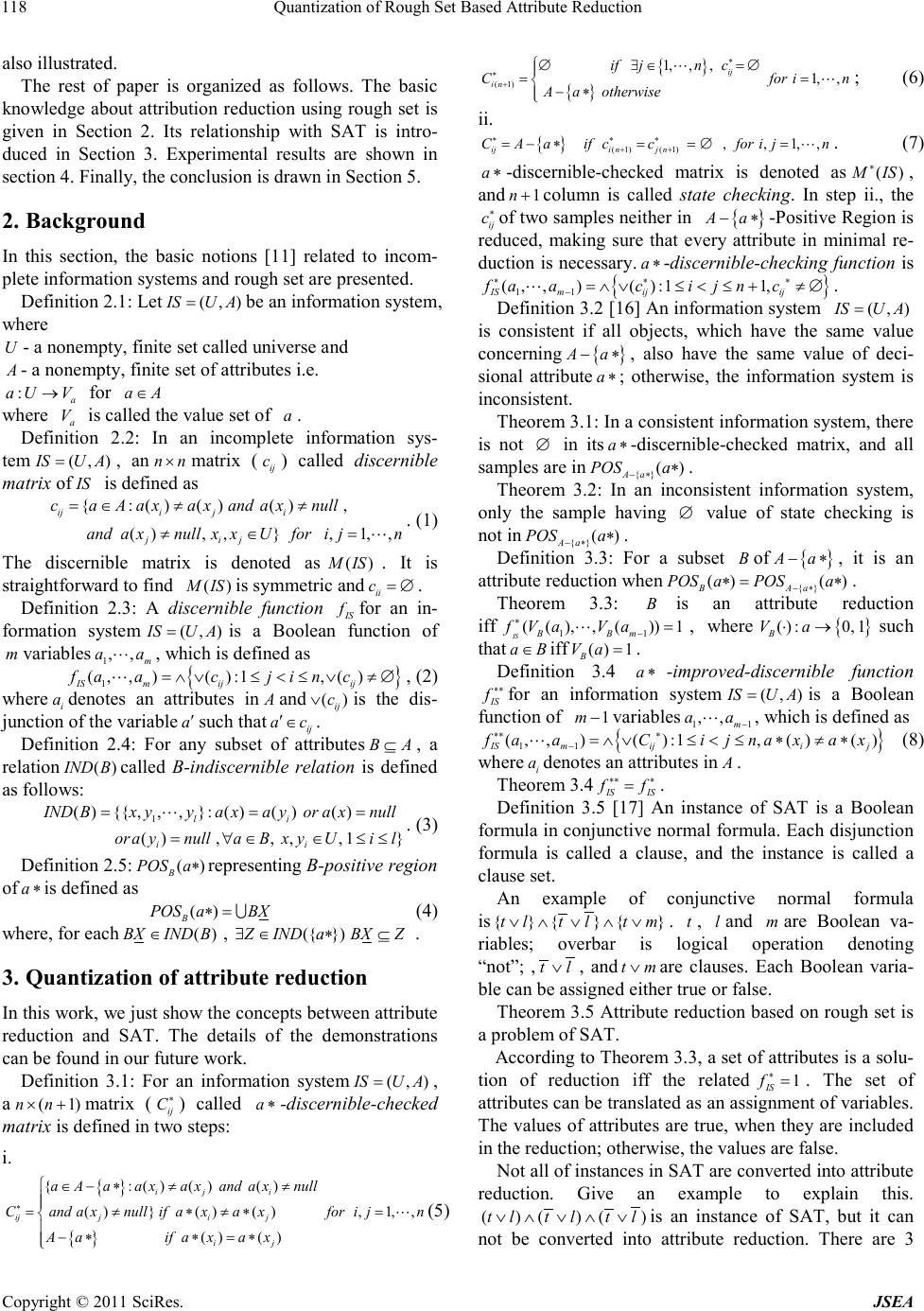 Quantization of Rough Set Based Attribute Reduction Copyright © 2011 SciRes. JSEA 118 also illustrated. The rest of paper is organized as follows. The basic knowledge about attribution reduction using rough set is given in Section 2. Its relationship with SAT is intro- duced in Section 3. Experimental results are shown in section 4. Finally, the c onclusion is drawn in Sec tion 5. 2. Background In this section, the basic notions [11] related to incom- plete information s ystems and rough set are p resented. Definition 2.1: Let (,)ISU A= be an information system, where U - a nonempt y, finite set called universe and A - a nonempt y, finite set of attributes i.e. : a aU V→ for aA∈ where a V is called the value set of a . Definition 2.2: In an incomplete infor matio n sys- tem (,)ISU A= , an nn× matrix ( ij c) called discernible matrix of IS is defined as {:()()(), (),,} ,1,, iji ji j ij caAa xa xanda xnull andaxnullxxUforijn =∈≠ ≠ ≠∈ = . (1) The discernible matrix is denoted as ()M IS . It is straightforward to find ()M IS is symmetric and ii c= ∅ . Definition 2.3: A discernible function IS f for an in- formation system (,)ISU A= is a Boolean function of m variables 1 ,, m aa , which is defined as { } 1 (,, )():1,() IS mijij faacjin c=∧ ∨≤<≤∨≠∅ , (2) where i a denotes an attributes in A and () ij c∨is the dis- junction of the variable a′ such that ij ac ′∈ . Definition 2.4: For any subset of attrib utes BA⊆ , a relation ()IND B called B-indiscern ible relation is defined as follows: 1 (){{,,,}:()( )() ( ),,,,1} li ii INDBx yya xayora xnull oraynullaBx yUil == = =∀∈∈ ≤≤ . (3) Definition 2 .5: () B POS a∗ representing B-positive region of a∗ is defined as () B POS aBX∗= (4) where, for each ()BXIND B∈ , ({ })ZIND aBXZ∃∈∗⊆ . 3. Quantization of attribute reduction In t h i s wo r k , we just sho w t he concepts between attribute reduction and SAT. The details of the demonstrations can b e found in our futur e work. Definition 3.1: For an information system (,)ISU A= , a ( 1)nn×+ matrix ( ij C ∗ ) called a∗ -discernible-checked matrix is defined in two steps: i. { } { } {:()()() ()}()(), 1,, () () ij i ijji j ij aAaa xa xand a xnull Candaxnullifa xaxforijn Aaifax ax ∗ ∈− ∗≠≠ =≠∗ ≠∗= −∗∗ =∗ (5) { } { } ( 1) 1, ,,1, , ij in if jn c Cfor in A aotherwise ∗ ∗ + ∅ ∃∈ =∅ = = −∗ ; (6) ii. { } ( 1)( 1) ,,1, , iji njn CAaifccfor ijn ∗ ∗∗ ++ =−∗= =∅= . (7) a∗ -discernible-c hecked matrix is denoted as ()M IS ∗ , and 1n+column is called state checking. In step ii., the ij c∗ of t wo sample s nei the r in { } Aa−∗ -Positi ve Regi on i s reduced, making sure that every attribute in minimal re- duction is necessary. a∗ -discernible-checking function is { } 11 (,,)() :11, IS mijij faacijn c ∗ ∗∗ −=∧ ∨≤<≤+≠∅. Definition 3 .2 [16] An in for mati on s yste m (,)ISU A= is consistent if all objects, which have the same value concerning { } Aa−∗ , also have the same value of deci- sional attribute a∗ ; otherwise, the information system is inconsistent. Theorem 3.1: In a consistent information system, there is not ∅ in its a∗ -discernible-checked matrix, and all samples are in {} () Aa POS a −∗ ∗. Theorem 3.2: In an inconsistent information system, only the sample having ∅ value of state checking is not in {} () Aa POS a −∗ ∗. Definition 3.3: For a subset B of { } Aa−∗ , it is an attribute reductio n when {} () () B Aa POS aPOSa −∗ ∗= ∗ . Theorem 3.3: B is an attribute reduction iff 11 (( ),,())1 IS B Bm fVa Va ∗ − = , where { } (): 0,1 B Va⋅→ such that aB ∈iff () 1 B Va= . Definition 3.4 a∗ -improved-discernible functio n IS f∗∗ for an information system (,)ISU A= is a Boolean func tio n of 1m− variables 11 ,, m aa − , which is defined as { } 11 ( ,,)():1,( )() IS mijij faaCijnax ax ∗∗ ∗ − =∧∨≤<≤∗≠∗ (8) where i a denotes an attrib utes in A . Theorem 3.4 IS IS ff ∗∗ ∗ = . Definition 3.5 [17] An instance of SAT is a Boolean for mula in c onju nctive nor mal for mula. E ach disjunction formula is called a clause, and the instance is called a clause set. An example of conjunctive normal formula is{ }{}{}tlt ltm∨∧ ∨∧∨. t , l and m are Boolean va- riables; overbar is logical operation denoting “not”; , tl∨ , and tm∨ are clauses. Each Boolean varia- ble can be assigned either true o r false. Theorem 3.5 Attribute reduction based on rough set is a problem of SAT. According to Theorem 3.3, a set of attributes is a solu- tion of reduction iff the related 1 IS f ∗ = . The set of attributes can be translated as an assignment of variables. The values of attributes are true, when they are included in the reduction; otherwise, the value s are false. Not all of instances in SAT are converted into attr ibute reduction. Give an example to explain this. ( )()()tltltl∨∧ ∨∧ ∨ is an instance of SAT, but it can not be converted into attribute reduction. There are 3 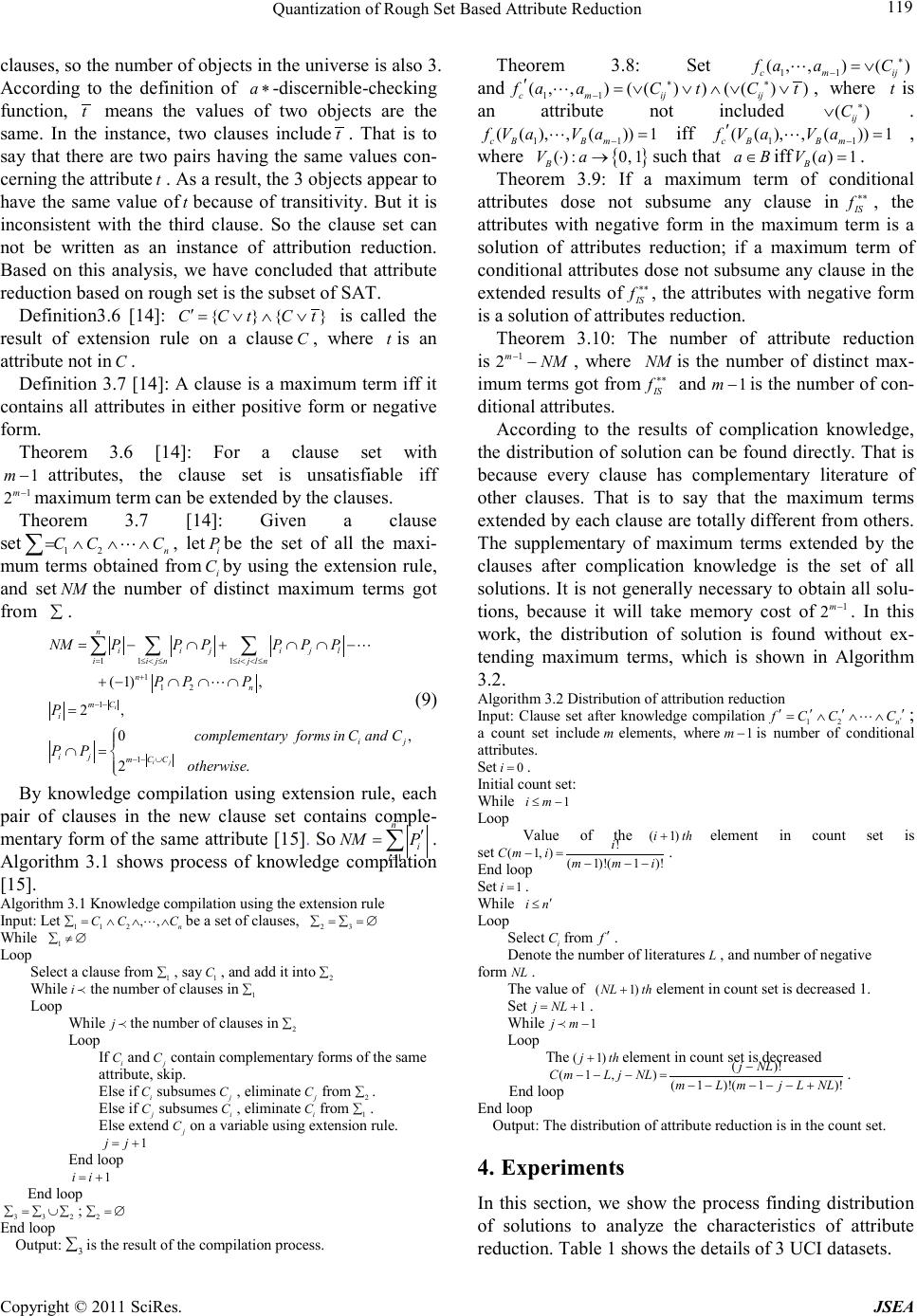 Quantization of Rough Set Based Attribute Reduction Copyright © 2011 SciRes. JSEA 119 clauses, so the number of objects in the universe is also 3 . According to the definition of a∗ -discernible-checking function, t means the values of two objects are the same. In the instance, two clauses includet. That is to say that there are two pairs having the same values con- cerning the attr ibute t . As a result, the 3 objects appear to have the same value of t because of transitivity. But it is inconsistent with the third clause. So the clause set can not be written as an instance of attribution reduction. Based on this analysis, we have concluded that attribute reduction based on rough set is the subset of SAT. Definition3.6 [14]: { }{}C CtCt ′= ∨∧ ∨ is called the result of extension rule on a clause C , where t is an attribute not in C . Definition 3 .7 [14]: A clause is a maximum term iff it contains all attributes in either positive form or negative form. Theorem 3.6 [14]: For a clause set with 1m− attributes, the clause set is unsatisfiable iff 1 2 m− maximum term can be extended by the clauses. Theorem 3.7 [14]: Given a clause set 12 n CC C=∧∧∧ ∑ , let i P be the set of all the maxi- mum terms obtained from i C by using the extension rule, and set NM the number of distinct maximum terms got from ∑ . 11 1 112 1 1 ( 1), 2, 0, 2. i ij n i ijijl i ijnijln nn mC i ij ij m CC NM PPPPPP PP P P complementaryforms in CandC PP otherwise =≤< ≤≤< <≤ + −− −− ∪ =−∩ +∩∩− +−∩ ∩ ∩ = ∩= ∑∑ ∑ (9) By knowledge compilation using extension rule, each pair of clauses in the new clause set contains comple- mentar y for m of the same attr ibute [15]. So 1 n i i NM P ′ = ′ =∑. Algorithm 3.1 shows process of knowledge compilation [15]. Algorithm 3.1 Knowledge compilation usin g the extension r ule Input: Let 11 2 ,, n CC C∑=∧∧∧be a set of clauses , 23 ∑=∑=∅ While 1 ∑ ≠∅ Loop Select a clause from 1 ∑, say 1 C , and add it into 2 ∑ While i the number of cla us e s in 1 ∑ Loop While j the number of cla us e s in 2 ∑ Loop If i C and j C contai n co mpl e m e ntar y for ms of the same attribute, skip. Else if i C subsumes j C , eliminate j C from 2 ∑. Else if j C subsumes i C , eliminate i C from 1 ∑ . Else extend j C on a variable using extension rule. 1jj=+ End loop 1ii= + End loop 332 ∑=∑ ∪∑ ; 2 ∑=∅ End loop Output: 3 ∑ is the result of the compilat ion process . Theorem 3.8: Set11 (, ,)() c mij fa aC ∗ −= ∨ and 11 (,,)(( ))(( )) c mijij fa aCtCt ∗∗ − ′=∨∨∧∨∨ , where t is an attribute not included () ij C ∗ ∨. 11 (( ),,())1 cB Bm fVa Va − = iff 11 (( ),,())1 c BBm fVa Va − ′= , where { } (): 0,1 B Va⋅→ such that aB ∈iff () 1 B Va= . Theorem 3.9: If a maximum term of conditional attributes dose not subsume any clause in IS f ∗∗ , the attributes with negative form in the maximum term is a solution of attributes reduction; if a maximum term of conditional attrib utes dose no t subsu me any c lause i n the extended results of IS f ∗∗ , the attributes with negative for m is a solution of attributes re duction. Theorem 3.10: The number of attribute reduction is 1 2 m NM − − , where NM is the number of distinct max- imu m terms got from IS f∗∗ and 1m− is the number of con- ditional attrib utes. According to the results of complication knowledge, the distributio n of sol utio n can be found directl y. That is because every clause has complementary literature of other clauses. That is to say that the maximum terms extended by each clause are totall y differe nt from others. The supplementary of maximum terms extended by the clauses after complication knowledge is the set of all solutions. It is not generally necessar y to ob tain all solu- tions, because it will take memory cost of1 2m−. In this work, the distribution of solution is found without ex- tending maximum terms, which is shown in Algorith m 3.2. Algorithm 3.2 Distribution of a ttribution reduction Input: Clause set after knowledge compilation 12 n fCC C ′ ′′′ ′ = ∧∧∧ ; a count set include m elements, where 1m− is number of con ditional attributes. Set 0i= . Initial c o u nt se t: While 1im ≤− Loop Value of the ( 1)ith+ element in count set is set ! (1,)(1)!(1)! i Cm immi −= − −− . End loop Set 1i= . While in ′ ≤ Loop Select i C from f′ . Denote the number o f literatures L , and number of negative form NL . The va lue of ( 1)NL th+ element i n count set is decreased 1. Set 1j NL=+ . While 1jm− Loop The ( 1)jth+ element in count set is decreased ( )! (1, ) ( 1)!( 1)! j NL C mL jNLmL mjL NL − −−−=−−−−−+. End loop End loop Output: The distribution of attribute reduction is in the count set. 4. Experiments In this section, we show the process finding distribution of solutions to analyze the characteristics of attribute reduction. Table 1 shows the details of 3 UCI datase ts. 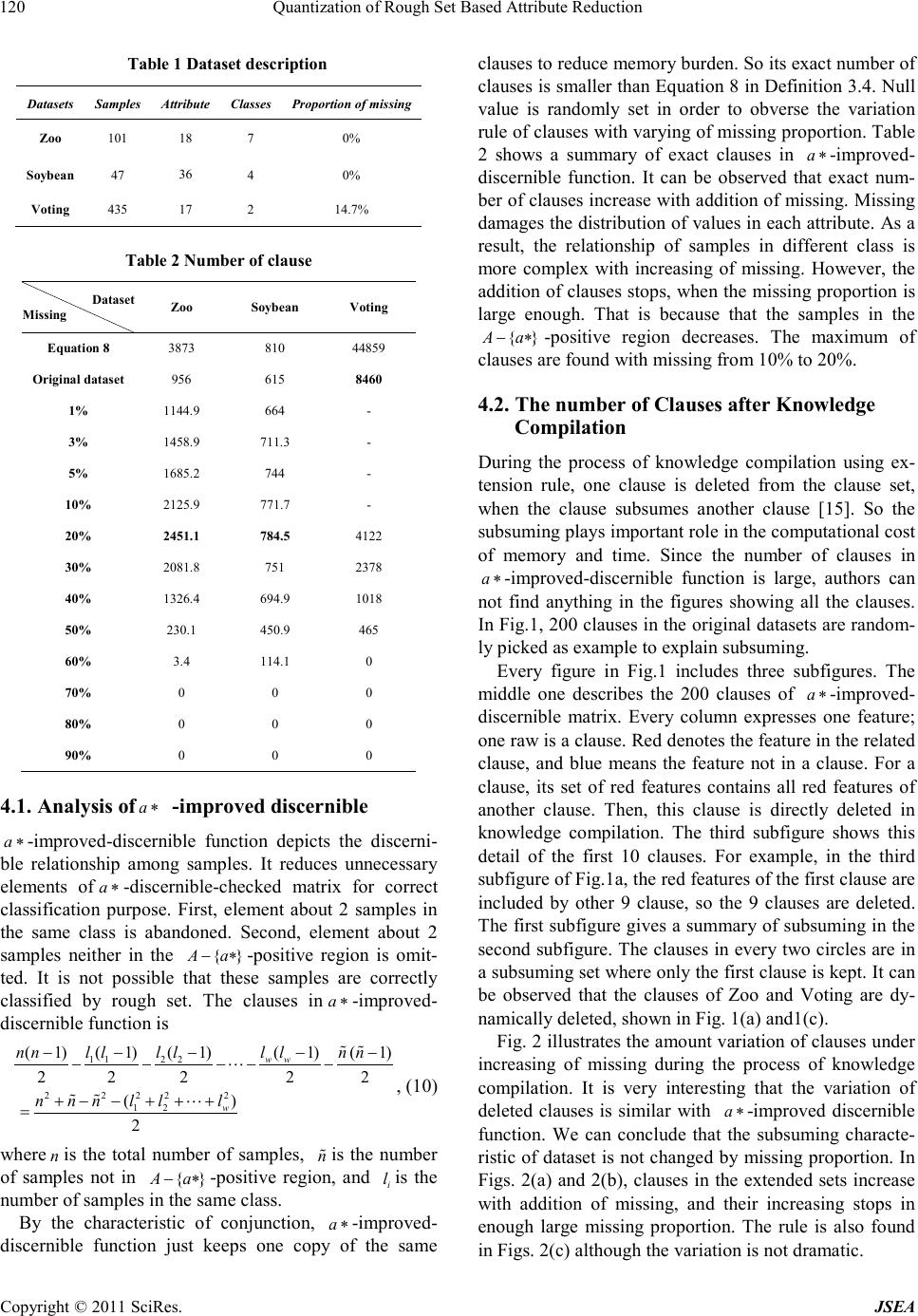 Quantization of Rough Set Based Attribute Reduction Copyright © 2011 SciRes. JSEA 120 Table 1 Dataset d es cription Datasets Samples Attribute Classes Proportion of missing Zoo 101 18 7 0% Soybean 47 36 4 0% Voting 435 17 2 14.7% Table 2 Number of clause Dataset Miss ing Zoo Soybean Voting Equation 8 3873 810 44859 Original datase t 956 615 8460 1% 1144.9 664 - 3% 1458.9 711.3 - 5% 1685.2 744 - 10% 2125.9 771.7 - 20% 2451.1 784.5 4122 30% 2081.8 751 2378 40% 1326.4 694.9 1018 50% 230.1 450.9 465 60% 3.4 114.1 0 70% 0 0 0 80% 0 0 0 90% 0 0 0 4.1. Analysis of a∗ -improved discernible a∗ -improved-discernible function depicts the discerni- ble relationship among samples. It reduces unnecessary elements of a∗ -discernible-checked matrix for correct classification purpose. First, element about 2 samples in the same class is abandoned. Second, element about 2 samples neither in the {}Aa−∗ -positive region is omit- ted. It is not possible that these samples are correctly classified by rough set. The clauses in a∗ -improved- discernible f unction is 112 2 22 222 12 ( 1)(1)(1)(1)(1) 22222 () 2 ww w nnl lllllnn n nnlll −− −−− − −−−− +−−+ ++ = , (10) where n is the total number of samples, n is the number of samples not in {}Aa−∗ -positive region, and i l is the number of samples in the sa m e class. By the characteristic of conjunction, a∗ -improved- discernible function just keeps one copy of the same clauses to reduce memor y burden. So its exact number of clauses is smaller tha n Equation 8 in Definitio n 3.4. Null value is randomly set in order to obverse the variation rule o f c laus es with var ying of mi ssi ng proportion. Table 2 shows a summary of exact clauses in a∗ -improved- discernible function. It can be observed that exact num- ber of clauses increase with addition of missing. Missing damages the distrib ution of values i n each attribute. As a result, the relationship of samples in different class is more complex with increasing of missing. However, the addition of clauses stops, whe n the missi ng pro portion is large enough. That is because that the samples in the {}Aa−∗ -positive region decreases. The maximum of clauses are found with missing from 10% to 20%. 4.2. The number of Clauses after Knowledge Compilation During the process of knowledge compilation using ex- tension rule, one clause is deleted from the clause set, when the clause subsumes another clause [15]. So the subsuming p lays importa nt rol e in the computational cost of memory and time. Since the number of clauses in a∗ -improved-discer nible functio n is large, authors can not find anything in the figures showing all the clauses. In Fi g.1, 2 00 c lauses i n the original datasets are random- ly picked as example to explain subsuming. Every figure in Fig.1 includes three subfigures. The middle one describes the 200 clauses of a∗ -improved- discernible matrix. Every column expresses one feature; one ra w is a clause. Red denotes the feature in the related clause, and blue means the feature not in a clause. For a clause, its set of red features contains all red features of another clause. Then, this clause is directly deleted in knowledge compilatio n. The third subfigure shows this detail of the first 10 clauses. For example, in the third sub fig ure o f Fi g. 1a, the red features of the first clause are included by other 9 clause, so the 9 clauses are deleted. The first subfigure gives a summary of subsuming in the second subfigure. The clauses in every two circles are in a subsu mi ng set where only the first clause is kept. It ca n be observed that the clauses of Zoo and Voting are dy- namically del eted, shown in F ig. 1(a) and 1(c). Fig. 2 illustrates t he amount variatio n of clauses under increasing of missing during the process of knowledge compilation. It is very interesting that the variation of deleted clauses is similar with a∗ -improved discernible function. We can conclude that the subsuming characte- ristic of dataset is not changed by missing proportion. In Figs. 2(a) and 2(b), clauses in the extended sets increase with addition of missing, and their increasing stops in enough large missing proportion. The rule is also found in Fi gs . 2(c ) although the variation is not dramatic. 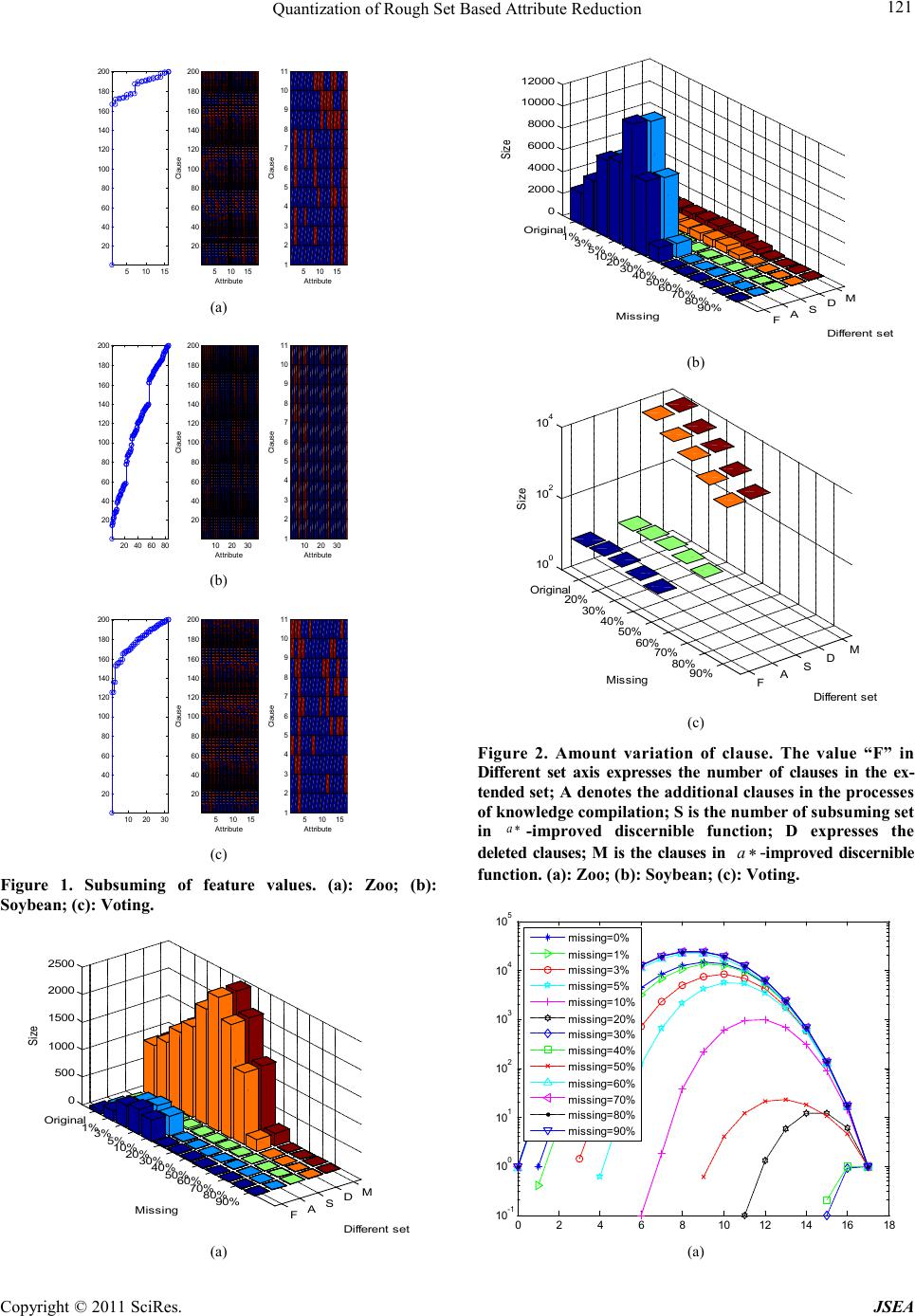 Quantization of Rough Set Based Attribute Reduction Copyright © 2011 SciRes. JSEA 121 510 15 20 40 60 80 100 120 140 160 180 200 Attribute Clause 510 15 1 2 3 4 5 6 7 8 9 10 11 Attribute Clause 51015 20 40 60 80 100 120 140 160 180 200 (a) 10 2030 20 40 60 80 100 120 140 160 180 200 Attribute Clause 10 20 30 1 2 3 4 5 6 7 8 9 10 11 Attribute Clause 20 40 60 80 20 40 60 80 100 120 140 160 180 200 (b) 510 15 20 40 60 80 100 120 140 160 180 200 Attribute Clause 510 15 1 2 3 4 5 6 7 8 9 10 11 Attribute Clause 10 20 30 20 40 60 80 100 120 140 160 180 200 (c) Figure 1. Subsuming of feature values. (a): Zoo; (b): Soybean; (c): Voting. FAS DM Original 1% 3% 5% 10% 20% 30% 40% 50% 60% 70% 80% 90% 0 500 1000 1500 2000 2500 Different set Miss ing Siz e (a) FAS DM Origi nal 1% 3% 5% 10% 20% 30% 40% 50% 60% 70% 80% 90% 0 2000 4000 6000 8000 10000 12000 Different set Miss ing Siz e (b) FAS DM Original 20% 30% 40% 50% 60% 70% 80% 90% 10 0 10 2 10 4 Different set Miss ing Siz e (c) Fig ure 2. Amount variation of clause. The value “F” in Different set axis expresses the number of clauses in the ex- tended set; A denotes the additi onal clauses in the proces ses of knowledge compila tion; S is the number of subsuming set in a∗ -improved discernible function; D expresses the deleted clauses; M is the clauses in a∗ -improved dis c er n i bl e function. (a): Zoo; (b): Soybean; (c): Voting. 02468101214 16 18 10 -1 10 0 10 1 10 2 10 3 10 4 10 5 missing=0% missing=1% missing=3% missing=5% missing=10% missing=20% missing=30% missing=40% missing=50% missing=60% missing=70% missing=80% missing=90% (a) 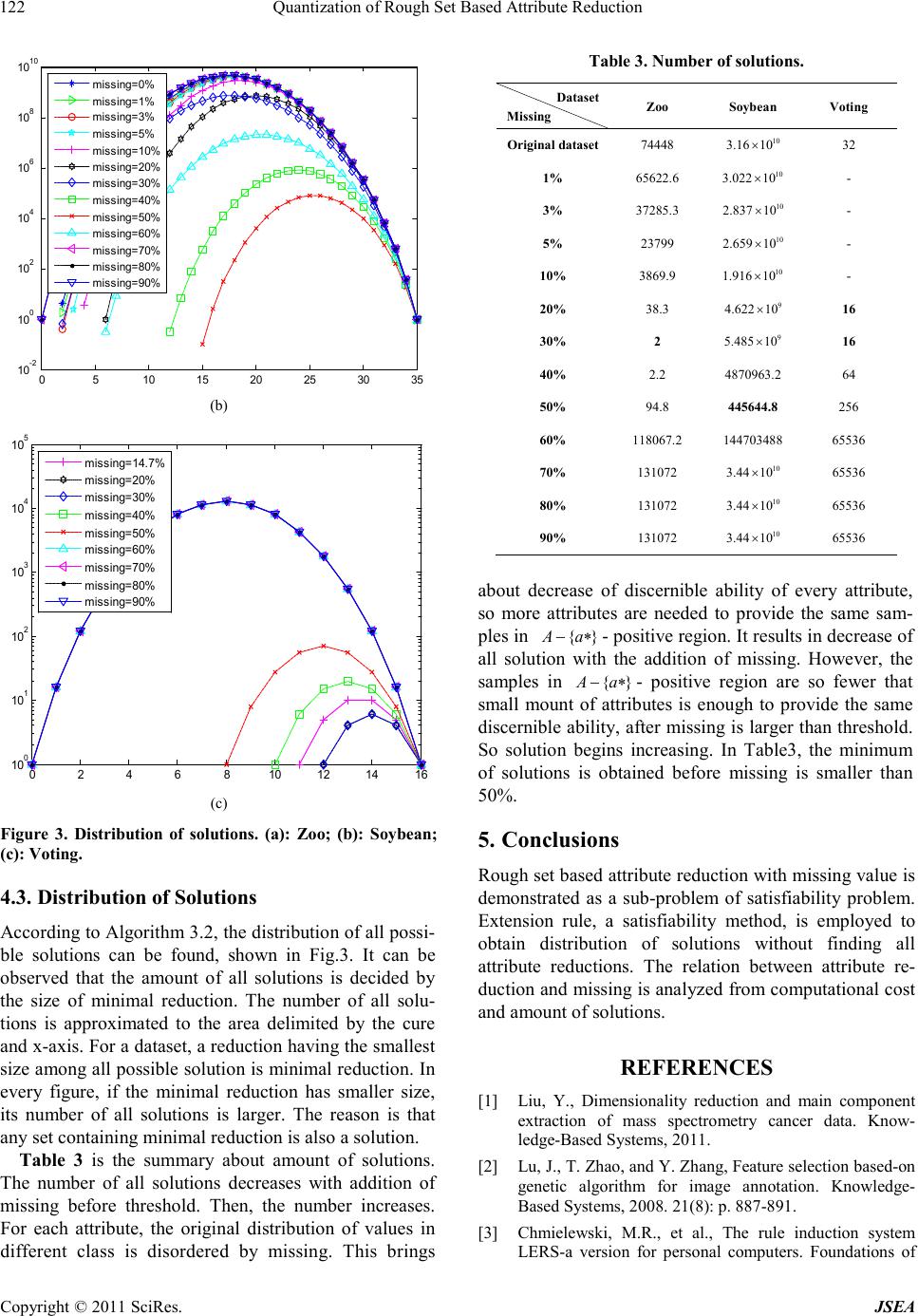 Quantization of Rough Set Based Attribute Reduction Copyright © 2011 SciRes. JSEA 122 0510 15 20 25 30 35 10 -2 10 0 10 2 10 4 10 6 10 8 10 10 missing=0% missing=1% missing=3% missing=5% missing=10% missing=20% missing=30% missing=40% missing=50% missing=60% missing=70% missing=80% missing=90% (b) 0246810 12 14 16 10 0 10 1 10 2 10 3 10 4 10 5 missing=14.7% missing=20% missing=30% missing=40% missing=50% missing=60% missing=70% missing=80% missing=90% (c) Figure 3. Distribution of solutions. (a): Zoo; (b): Soybean; (c): Voting. 4.3. Distribution of Solutions According to Algorithm 3.2, the distributio n of all possi- ble solutions can be found, shown in Fig.3. It can be observed that the amount of all solutions is decided by the size of minimal reduction. The number of all solu- tions is approximated to the area delimited by the cure and x -axis. For a d ataset, a reduction having the smallest size among all po ssible solution is minimal reductio n. In every figure, if the minimal reduction has smaller size, its number of all solutions is larger. The reason is that any set containing minimal re d uction is also a solution. Table 3 is the summary about amount of solutions. The number of all solutions decreases with addition of missing before threshold. Then, the number increases. For each attribute, the original distribution of values in different class is disordered by missing. This brings Table 3. Number of solutions. Dataset Missing Zoo Soyb ean Voting Original datase t 74448 10 3.16 10× 32 1% 65622.6 10 3.022 10× - 3% 37285.3 10 2.837 10× - 5% 23799 10 2.659 10× - 10% 3869.9 10 1.916 10× - 20% 38.3 9 4.622 10× 16 30% 2 9 5.485 10× 16 40% 2.2 4870963.2 64 50% 94.8 445644.8 256 60% 118067.2 144703488 65536 70% 131072 10 3.44 10× 65536 80% 131072 10 3.44 10× 65536 90% 131072 10 3.44 10× 65536 about decrease of discernible ability of every attribute, so more attributes are needed to provide the same sam- ples in {}Aa−∗ - positive region. It results in decrease of all solution with the addition of missing. However, the samples in {}Aa−∗ - positive region are so fewer that small mount of attributes is enough to provide the same discernible ab ility, after missing is lar ger t han threshold. So solution begins increasing. In Table3, the minimum of solutions is obtained before missing is smaller than 50%. 5. Conclusions Rough set based attr ibute reduction with missing value is demonstrated as a sub-problem of satisfiability problem. Extension rule, a satisfiability method, is employed to obtain distribution of solutions without finding all attribute reductions. The relation between attribute re- duction and missin g is anal yzed from computational co st and amount of solutions. REFERENCES [1] Liu, Y., Dimensionality reduction and main component extraction of mass spectrometry cancer data. Know- ledge-Based Systems, 2011. [2] Lu, J., T. Zh ao, and Y. Zhan g, Feature selecti on based -on genetic algorithm for image annotation. Knowledge- Based Systems, 2008. 21(8): p. 887-891. [3] Chmielewski, M.R., et al., The rule induction system LERS-a version for personal computers. Foundations of  Quantization of Rough Set Based Attribute Reduction Copyright © 2011 SciRes. JSEA 123 Computing and Decision Sciences, 1993. 18(3-4): p. 181-212. [4] Booth, D.E., Analysis of Incomplete Multivariate Data. Te c hnom e t ri c s , 2000. 42(2): p. 213-214. [5] Hudak, A.T., et al., Nearest neighbor imputation of spe- cies-level, plot-scale forest structure attributes from Li- DAR data. Remote Sensing of Environment, 2008. 112(5): p. 2232-2245. [6] Pelckmans, K., et al., Handling missing values in support vector machine classifiers. Neural Networks, 2005. 18(5-6): p. 684-692. [7] Myers, J.W., K.B. Laskey, and T. Levitt. Learning Baye- sian networks from incomplete data with stochastic search algorithms. 1999. Morgan Kaufmann Publishers Inc. [8] Kryszkiewicz, M., Rough set approach to incomplete information systems. Information sciences, 1998. 112(1): p. 39-49. [9] Slowinski, R. and J. Stefanowski, Rough classification in incomplete information systems. Mathematical and Computer Modelling, 1989. 12(10-11): p. 1347-1357. [10] Pawlak, Z., Rough sets. International Journal of Parallel Progr a m ming, 1982. 11( 5): p. 341-356. [11] Leung, Y. an d D. Li, Maximal co nsis tent blo ck technique for rule acquisition in incomplete information systems. Information sciences, 2003. 153: p. 85-106. [12] Meng, Z. and Z. Shi, A fast approach to attribute reduc- tion in incomplete decision systems with tolerance rela- tion-based rough sets. Information sciences, 2009. 17 9(16): p. 2774-2793. [13] Liang, J., Z. Shi, and D. Li, The information entropy, rough entropy and knowledge granulation in rough set theory. International Journal of Uncertainty Fuzziness and Knowledge-Ba sed Systems , 2004. 12 ( 1) : p. 37-46. [14] Hai, L., S. Jigui, and Z. Yimin, Theorem proving based on the extension rule. Journal of Automated Reasoning, 2003. 31 ( 1): p. 11-21. [15] Hai, L. and S. Jigui, Knowledge compilation using the extension rule. Journal of Automated Reasoning, 2004. 32(2): p. 93-102. [16] Grzymala-Busse, J.W., Managing uncertainty in expert systems. Vol. 143. 1991: Springer. [17] Kirkpatrick, S. and B. Selman, Critical behavior in the satisfiability of random boolean expressions. Science, 1994. 26 4( 5 16 3) : p. 12 97-1301. |

